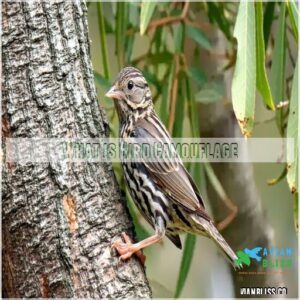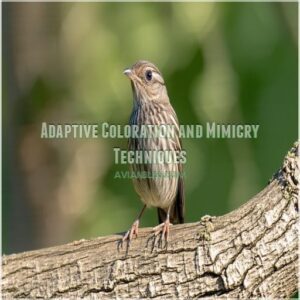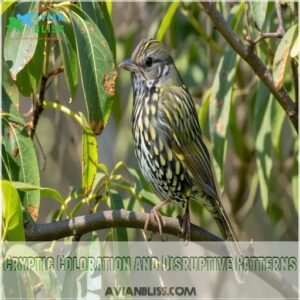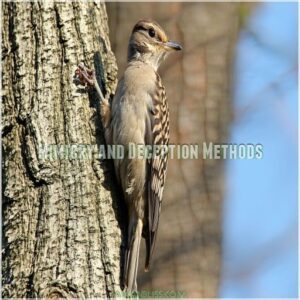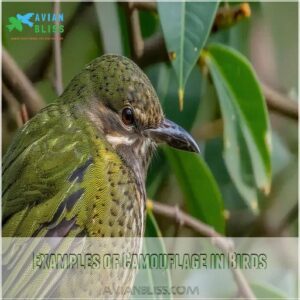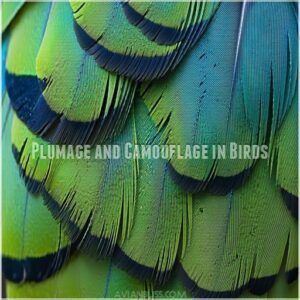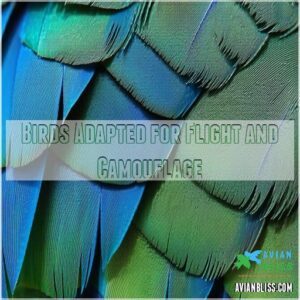This site is supported by our readers. We may earn a commission, at no cost to you, if you purchase through links.

Many use cryptic coloration and patterns to blend seamlessly into their environments, like a pebble disappearing on a gravel beach.
Some adopt mimicry, fooling predators by resembling twigs or leaves.
Ever noticed that shadowy shape flitting between forest shadows?
That’s countershading in action, where the bird’s lighter underside minimizes visibility against sun-dappled leaves.
These tactics let birds stay one step ahead of predators and find mates without becoming dinner.
Next time you take a stroll in nature, keep an eye out—you might just spot these masters of disguise.
Table Of Contents
- Key Takeaways
- What is Bird Camouflage
- Types of Camouflage in Birds
- Techniques of Bird Camouflage
- Examples of Camouflage in Birds
- Bird Beaks and Feet Adaptations
- Plumage and Camouflage in Birds
- Mastering The Art of Camouflage
- Birds Adapted for Flight and Camouflage
- Camouflage in Urban Environments
- Importance of Bird Camouflage Techniques
- Frequently Asked Questions (FAQs)
- Do birds have mastered the art of camouflage?
- Why do birds camouflage?
- Where can I find a camouflage bird?
- Why is camouflage important?
- What are some examples of camouflage in birds?
- Can you spot camouflage in birds?
- Which animal shows very good camouflage technique?
- What are the techniques of camouflage?
- How can a parrot camouflage itself?
- How do birds camouflage?
- How do birds choose camouflage locations?
- What affects a birds camouflage effectiveness?
- How do young birds learn to camouflage?
- Can bird camouflage fail against certain predators?
- Do environmental changes alter bird camouflage strategies?
- Conclusion
Key Takeaways
- You’ll find that birds use impressive techniques like cryptic coloration, mimicry, and countershading to blend into their surroundings, avoiding predators and increasing their survival chances.
- Birds have adapted various camouflage strategies to match their specific habitats, whether it’s forests, deserts, wetlands, or urban environments, showcasing their incredible evolutionary skills.
- Camouflage isn’t just about hiding from predators; it’s also crucial for success in mating and reproduction, allowing birds to attract mates while remaining safely concealed.
- Environmental changes can significantly alter bird camouflage strategies, as birds adapt their colors and patterns to blend with shifting landscapes, like forests turning into urban areas.
What is Bird Camouflage
When you think of bird camouflage, picture feathered masters of disguise blending seamlessly into their surroundings to dodge predators and sneak up on prey.
It’s a fascinating evolutionary trick that’s essential for survival, almost like having a cloak of invisibility in the wild!
Definition of Camouflage in Birds
Ever wonder how birds vanish into their surroundings?
Bird camouflage is nature’s disguise, using colors and patterns to blend seamlessly into habitats.
Through cryptic and disruptive coloration, birds practice these stealthy techniques to dodge predators or sneak up on prey.
Here’s a breakdown:
- Color Matching: Mimic surroundings.
- Pattern Disruption: Breakup body outline.
- Adaptive Shifts: Alter hues for seasons.
Importance of Camouflage in Bird Survival
So, you’ve learned what bird camouflage is. Now, let’s see why it matters.
Camouflage is a bird’s best friend, a lifesaver against hungry predators.
It’s all about survival; think of it as nature’s ultimate hide-and-seek.
Good camouflage means more chances to find food, raise chicks, and simply live longer.
It boosts mating success too—a well-hidden bird is more likely to attract a mate.
Ultimately, successful camouflage provides an evolutionary advantage, impacting bird populations and conservation efforts.
Evolutionary History of Bird Camouflage
You’ve seen how bird camouflage means survival in their daily game of hide-and-seek with predators.
But how did these fascinating abilities develop?
Stretch back in time, and you’ll find that camouflage evolution started with ancient avian ancestors.
This adaptive evolution led to a rich tapestry of techniques.
Birds mastered disruptive coloration and diverse camouflage strategies, coevolving alongside their predators.
Types of Camouflage in Birds
You’ve seen birds blend into their surroundings with astonishing skill, mastering everything from coloration to mimicry.
By altering their shapes, sizes, and colors, they turn the art of disguise into an evolutionary masterpiece.
Coloration and Patterns for Blending
How do birds pull off their mesmerizing camouflage tricks?
With coloration and patterns, they’re like master artists blending into their surroundings.
Camouflage techniques like cryptic and disruptive coloration help them dodge predators.
Picture a bird matching the forest’s hues or rocking spots and stripes to confuse hungry eyes.
This artful adaptation isn’t just clever; it’s a key survival strategy.
Shape and Size Alterations for Concealment
Some birds use clever tricks to hide from predators.
By puffing their feathers, they appear larger and more intimidating, while others flatten their bodies to blend seamlessly with the ground.
Wading birds mimic reeds, standing still with necks outstretched, perfect for disappearing into their habitat.
These shape and size alterations are a masterclass in bird camouflage, ensuring survival and safety.
Adaptive Coloration and Mimicry Techniques
Ever wondered how birds outwit predators?
Birds use adaptive coloration and mimicry to stay hidden.
Mimicry examples include:
- Cryptic coloration: Matching surroundings to become invisible.
- Disruptive patterns: Breaking up body outlines.
- Predator deception: Imitating threats.
- Evolutionary pressures: Driving adaptation.
These techniques offer camouflage benefits, helping birds survive and thrive amid constant challenges from nature.
Techniques of Bird Camouflage
You’re about to discover how birds masterfully use cryptic coloration, mimicry, and countershading to stay safe from predators, often making them nature’s own version of stealth technology.
These techniques might seem like fancy magic tricks, but they’re essential skills that help birds blend into their surroundings, adding a bit of mystery and flair to their survival tactics.
Cryptic Coloration and Disruptive Patterns
Bird camouflage isn’t just about matching colors; it’s about clever patterns too.
By paying close attention to the arrangement of light and dark areas, the boldness of markings, and any striking white on wings or tails, as seen in identifying birds by color, cryptic coloration lets birds disappear into their backgrounds.
Disruptive patterns break up their outlines, making them harder to spot.
Think of it like a visual game of hide-and-seek!
| Bird Species | Coloration | Pattern | Habitat | Camouflage Effect |
|---|---|---|---|---|
| Common Nighthawk | Mottled brown, gray | Irregular, disruptive | Night sky | Blends with night sky |
| Snowy Owl | White | Uniform | Snow | Disappears in snowy areas |
| American Woodcock | Brown, black | Streaked, cryptic | Forest floor | Blends with leaf litter |
| Eastern Meadowlark | Brown, yellow | Streaked, disruptive | Grasslands | Breaks up its outline |
| Common Snipe | Brown, black | Streaked, cryptic | Wetlands | Blends with marsh plants |
Clever, right?
Mimicry and Deception Methods
Imagine this: a clever bird pretending to be a branch, masterfully outwitting predators.
Mimicry evolution has turned some birds into true masters of deception.
They employ animal mimicry and camouflage techniques to blend in or fool others.
These avian camouflagers play a fascinating role in predator-prey dynamics.
Such deception methods can mean the difference between life and death.
Countershading and Shadows for Concealment
Countershading tricks predators by making birds blend with their surroundings.
With light bellies and dark backs, birds achieve an optical illusion, flattening their appearance.
Shadow mimicry plays a part, as the light and shade balance fools keen eyes.
This visual camouflage is like wearing nature’s invisibility cloak, enhancing camouflage effectiveness by deceiving predators.
It’s nature’s clever way of background matching.
Examples of Camouflage in Birds
You can find birds showcasing incredible camouflage techniques everywhere, from shadowy forests to sun-soaked deserts.
Imagine trying to spot a Snowy Owl blending into its snowy habitat or a Bittern stretching like a reed in a marsh—nature’s magic at its best!
Forest and Woodland Camouflage
Imagine you’re walking through a forest, looking for birds that seem to vanish into the scenery.
That’s the magic of forest and woodland camouflage.
Birds use bark mimicry and leaf litter blending to disappear.
Seasonal camouflage helps them match changing environments.
Understory camouflage, with clever background matching and camouflage patterns, makes them nearly invisible in rich forest habitats.
Desert and Grassland Camouflage
Leaving the forest’s shadows, you’re now meeting birds that master desert and grassland camouflage.
Think about birds with sand-colored plumage, perfectly blending with dull terrains.
Grassland birds are sneaky too, using adaptive coloration and mimicry techniques to outwit predators.
Their camouflage patterns make them nearly invisible, like a chameleon against a sandy backdrop.
It’s survival at its finest, proving nature’s clever tricks.
Wetland and Aquatic Camouflage
While exploring dry expanses, don’t miss wetlands brimming with life and clever camouflage.
Birds like the Great Blue Heron blend seamlessly with reeds using aquatic color patterns, providing excellent cover.
Marsh Wrens employ mimicry in marshy undergrowth, disappearing from view.
Underwater, fish-eating birds adapt brilliantly, showing how avian and animal camouflage in wetland habitats enhances survival through smart bird adaptations.
Bird Beaks and Feet Adaptations
You’ll discover how a bird’s beak shape directly relates to its diet, whether it’s cracking seeds or tearing meat.
A bird’s beak shape is directly related to its diet.
Similarly, their feet – from webbed to clawed – are perfectly adapted for their environment, be it swimming, perching, or grasping prey.
Specialized Beaks for Food Acquisition
From matching leaves to honing hunting skills, birds use beaks as specialized tools for survival.
Think of a finch’s sturdy beak cracking seeds, or a hummingbird’s long beak sipping nectar, and explore the various Bird beak shape designs that suit their feeding habits.
Each shape is perfectly suited to specific food sources, showcasing nature’s clever designs.
These adaptive beaks highlight evolution’s role in feeding habits, linking camouflage with available nourishment in the wild.
Foot Structures and Nails for Perching and Grasping
Birds sport an array of claw shapes and toe arrangements, ideal for perching and grasping.
Imagine a tiny gymnast swinging on branches; it’s all about balance and grip.
Perching adaptations vary, with grasping strength adjusted to each bird’s needs.
Some species showcase unique foot size variations, enhancing their ability to navigate diverse environments—a reflection of avian adaptations and bird camouflage strategies.
Plumage and Camouflage in Birds
You might find it impressive that birds use their plumage not just for looking good during courtship but also for hiding in plain sight from predators.
Feather maintenance, including molting, is essential, as it helps maintain both the camouflage and agility necessary for survival.
Attractive Plumage for Mating and Courtship
A bird’s plumage can be a vibrant billboard for love.
It shows off with dazzling colors and patterns, inviting potential mates.
These feathered suits come with flair and flair-ups, sparking romances and rivalries.
Explore the intricacies of bird courtship displays, where:
- Plumage variation signals health and energy.
- Courtship displays mesmerize and allure.
- Mating rituals underscore nature’s drama.
Specialized Feathers for Stealth and Agility
Owls are the silent ninjas of the bird world, thanks to their specialized feathers that enable stealthy pursuits.
The unique structure of these feathers dampens sound, giving them a ghostly edge.
Raptors, with their strong, streamlined feathers, achieve remarkable flight efficiency, enhancing their speed and agility.
Nature boasts a masterclass in bird adaptations, balancing beauty and practicality.
| Feature | Description |
|---|---|
| Owl Feathers | Silent flight, muffling edges |
| Raptor Feathers | Strength, speed, streamlined |
| Feather Structure | Enhances flight efficiency |
| Flight Efficiency | Essential for predator hunting |
| Adaptations | Combines stealth and agility |
Molting and Feather Maintenance for Camouflage
Maintaining pristine plumage is essential for effective bird camouflage.
Regular molting cycles replace worn feathers, minimizing camouflage loss.
Birds can also benefit from using bird feather care products to keep their feathers in top condition.
Feather wear impacts coloration, so proper feather care is essential.
Color variation within a species often reflects environmental adaptation.
Think of it as a bird’s annual wardrobe refresh!
These processes help maintain their disguise.
Mastering The Art of Camouflage
When you’re observing birds mastering the art of camouflage, you’ll notice they don’t just rely on colors but also on clever behaviors.
These survival techniques help them blend into various environments, evading predators and surprising their prey.
Behavioral Adaptations for Concealment
Hiding in plain sight is an art many birds have mastered through clever behavior.
Their knack for blending into their surroundings, aptly termed "bird camouflage," is nature’s game of hide-and-seek.
Imagine:
- Puffing up feathers to mimic lush habitat textures.
- Freezing in place like an overlooked garden statue.
- Using mimicry strategies to imitate non-threatening objects.
These tricks help avoid predators and surprise prey effortlessly.
Environmental Factors Affecting Camouflage
Bird camouflage is a masterclass in adaptation, influenced by environmental factors like light, terrain, and seasonality.
Picture a chameleon of the avian world, deftly changing hues to blend into shifting habitats and climates, much like the bushtit’s unique camouflage-like plumage colors.
The environment shapes coloration and patterns, creating adaptive wonders.
Just like a coat swapped with the weather, these adaptations help birds thrive amidst nature’s dramatic stage.
Predator-Prey Dynamics and Camouflage
As you explore the predator-prey dynamics, imagine a heart-pounding chase scene right out of a nature documentary. The art of deception plays a key role here, with camouflage masking the hunter and the hunted. Birds also adapt their environments by creating hidden feeding spots using Camouflage bird feeders.
- Survival Tactics: Birds use camouflage to stay hidden from predators.
- Mimicry Marvels: Some birds even imitate their surroundings.
- Prey Detection: Predators adapt to find hidden prey.
- Sensory Perception: Keen senses hone in on subtle signs.
Birds Adapted for Flight and Camouflage
You might think birds are just show-offs with their vibrant plumage, but those feathers are cleverly designed for stealth and aerodynamics.
From wing shapes that whisper through the air to flight techniques that keep them hidden, birds master both flight and camouflage in fascinating ways.
Wing Shapes and Sizes for Stealth
Imagine a bird’s wingspan as the secret to its stealthy dance in the sky.
Each wing’s aspect ratio is a masterpiece of adaptation, fine-tuned for predator avoidance.
Feather structure plays a role too; it’s like nature’s cloaking device.
Birds that soar require different designs than those gliding silently—a fascinating example of animal camouflage and mimicry in action.
Flight Styles and Techniques for Concealment
Wing shape directly impacts flight style. Larger wings help birds soar effortlessly, like majestic eagles. Smaller wings enable quick, agile maneuvers, perfect for dodging branches.
Silent flight is key for hunting owls. They hover patiently, then swoop down for a surprise attack, particularly effective when using a car as a mobile blind.
Gliding is another stealthy technique, using air currents for effortless movement. These flight patterns are all part of a bird’s camouflage strategy, ensuring survival.
Feather Structure and Growth for Aerodynamics
In today’s world of flight and camouflage, feather structure and growth play a pivotal role.
Like tailoring a sleek suit for speed, nature’s crafted bird feathers with precise aerodynamics.
They evolve to catch air just right, letting birds soar and maneuver with grace.
These evolutionary marvels adapt and camouflage, showcasing the intricate dance between flight efficiency and environmental harmony.
Camouflage in Urban Environments
In bustling cities, birds have mastered the art of blending in by using buildings and trees as their safe havens.
Camouflage
You’ll find that even trash and debris can become ingenious camouflage materials for these urban survivalists.
Adaptations for Building and Tree Camouflage
Urban birds have mastered city life, blending with concrete jungles and cozying up in urban forests.
They cleverly alter their color variations for the perfect disguise, using tree bark mimicry and adaptations for concrete structures.
Birds showcase an impressive ability to imitate nature’s patterns and hues, seamlessly camouflaging within cities, highlighting the intricate dance between bird behavior and urban landscapes.
Trash and Debris as Camouflage Materials
Stroll through any city, and you might miss the clever urban bird adaptations happening right under your nose.
Picture pigeons integrating bits of trash into their feathers, seamlessly blending with concrete jungles.
It’s a sneaky survival strategy, using debris for concealment against prying predators.
This urban environment camouflage highlights how birds harness creativity, turning litter into lifelines.
Urban Bird Species With Unique Camouflage Techniques
Cities pulse with unexpected wildlife, like pigeons mastering urban camouflage through coloration and clever animal adaptations.
These city birds, with their gray and white feathers, blend seamlessly into concrete landscapes, using building blending to stay hidden.
Other urban dwellers, such as the House Sparrow’s adaptable habitats, showcase remarkable adaptability and camouflage skills to thrive in human-altered environments.
Trash concealment, an unusual strategy at first glance, becomes a boon for their survival, showcasing unique bird camouflage techniques in bustling environments.
Importance of Bird Camouflage Techniques
You’ve probably noticed that birds don’t just rely on their wings to survive; their camouflage skills are essential too.
Camouflage plays a key role in their survival and success.
From avoiding hungry predators to impressing potential mates, these techniques play a key role in their survival and success.
Survival and Predation Avoidance
Bird camouflage isn’t just about looking pretty; it’s a life-or-death game of hide-and-seek.
Think of it as nature’s ultimate survival kit.
Clever coloration helps birds avoid becoming a hawk’s lunch.
Predator-prey dynamics are in constant play; effective camouflage means more meals and fewer close calls.
Birds’ survival hinges on blending in, mastering the art of invisibility.
It’s a silent battle for survival, where camouflage is the ultimate weapon.
Mating and Reproduction Success
Imagine the drama of the breeding season where bird camouflage plays a starring role.
Birds use clever coloration as part of their mating rituals, helping them blend in while attracting mates.
Nest concealment becomes essential; after all, showing off without revealing too much is a delicate dance.
Animal adaptation strategies guarantee that territory defense doesn’t overshadow their secure nesting ambitions.
Conservation Implications of Bird Camouflage
While successful mating can boost populations, threats like habitat loss, climate change, pollution, and hunting pressure lead to population decline.
Birds like the brown birds with white spots, which have distinctive markings that aid in effective camouflage techniques, show how animal camouflage is essential for survival.
Bird adaptations in behavior and appearance enhance their chances, highlighting conservation implications.
Protecting these natural masters of disguise is key to safeguarding biodiversity.
Frequently Asked Questions (FAQs)
Do birds have mastered the art of camouflage?
Birds excel in camouflage, using colors, patterns, and body shapes to blend seamlessly into their surroundings.
This artful disguise helps them avoid predators and sneak up on prey.
Camouflage showcases nature’s incredible adaptability and survival instincts.
Why do birds camouflage?
You’ll find birds camouflage to avoid hungry predators and sneak up on tasty meals. It’s survival, pure and simple: hide from danger, hunt successfully. Camouflage is their superpower!
Where can I find a camouflage bird?
Head to marshes or forests where cleverly camouflaged birds hang out.
Look for a Common Potoo blending with tree branches or an American Bittern mimicking reeds.
Keep your eyes peeled; these masters of disguise are tricky to spot!
Why is camouflage important?
Just like a chameleon blends in to survive, camouflage helps animals, including birds, escape predators and sneak up on prey.
It’s nature’s clever disguise, ensuring safety and improving hunting success rates in the wild.
What are some examples of camouflage in birds?
Birds use camouflage cleverly, like the Tawny Frogmouth mimicking a tree branch or the Snowy Owl blending with snow.
The Common Nightjar’s mottled feathers resemble leaves, while the American Bittern imitates reeds in marshes.
Can you spot camouflage in birds?
Imagine trying to spot Waldo in the woods: birds use camouflage the same way.
With feathers mimicking leaves or snow, they’re hidden in plain sight.
Look closely, and you might spot one blending seamlessly into its surroundings.
Which animal shows very good camouflage technique?
The octopus masters camouflage through color, texture, and pattern changes, blending seamlessly with surroundings.
Its ability to mimic rocks, reefs, and ocean floor rivals a magician’s trick, showcasing nature’s artistry in hiding right before your eyes.
What are the techniques of camouflage?
Imagine this: creatures blend effortlessly into their surroundings using techniques like color matching, pattern mimicry, and shape alteration.
These strategies help them avoid predators and sneak up on prey, showcasing nature’s genius in the art of survival.
How can a parrot camouflage itself?
Parrots, unlike many birds, don’t rely on camouflage. Their vibrant colors serve as identification and attract mates, not hide them. Think of them as nature’s flashy billboards!
How do birds camouflage?
Birds master camouflage by blending into their environment, using colors and patterns on their feathers to hide from predators or surprise prey.
Techniques include mimicking surroundings, altering shapes, and changing colors to suit different habitats.
How do birds choose camouflage locations?
You’ll often find birds choosing camouflage locations that match their plumage, like a mottled forest floor or snow-covered field.
They seek spots that hide them from predators and enhance their chances of catching prey.
What affects a birds camouflage effectiveness?
Imagine a chameleon, its survival hinging on blending with its backdrop.
Camouflage effectiveness depends on habitat, plumage contrast, predator type, and movement.
Each factor plays a key role in staying hidden from threats.
How do young birds learn to camouflage?
Young birds learn camouflage from observing their surroundings, mimicking adult birds, and through natural selection.
They adapt plumage and behaviors suited to their environment, ensuring survival by blending in with foliage, snow, or urban settings.
Can bird camouflage fail against certain predators?
Bird camouflage can fail against predators with superior vision or in changing environments.
Predators like hawks or even humans with binoculars might spot camouflaged birds, especially if the background changes, revealing the bird’s presence.
Do environmental changes alter bird camouflage strategies?
Environmental changes can shift bird camouflage strategies as they adapt their colors and patterns to new landscapes.
When habitats transform, like forests turning to urban areas, birds might alter plumage to blend with concrete and buildings.
Conclusion
Remarkably, over 70% of bird species utilize some form of camouflage.
You’ve now explored the fascinating bird camouflage techniques employed for survival.
From cryptic coloration to mimicry and countershading, these strategies are essential for avoiding predators and finding mates.
Remember, next time you’re birdwatching, consider the intricate ways these feathered friends use their environment for protection.
Understanding these fascinating bird camouflage techniques provides a deeper appreciation for the natural world’s complexity.

